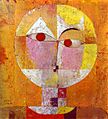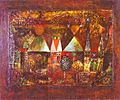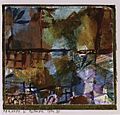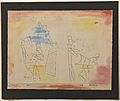Paul Klee facts for kids
Quick facts for kids
Paul Klee
|
|
|---|---|
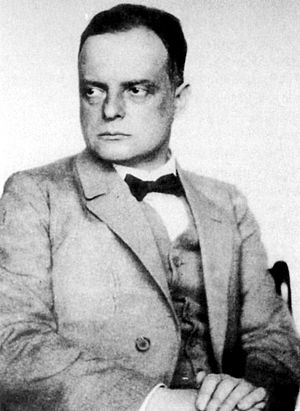
Klee in 1926
|
|
| Born | December 18, 1879 Münchenbuchsee, Switzerland
|
| Died | 29 June 1940 (aged 60) Muralto, Switzerland
|
| Nationality | German |
| Education | Academy of Fine Arts, Munich |
| Known for | Painting, drawing, watercolor, printmaking |
|
Notable work
|
More than 10,000 paintings, drawings, and etchings, including Angelus Novus (1920), Twittering Machine (1922), Fish Magic (1925), Viaducts Break Ranks (1937). |
| Movement | Expressionism, Bauhaus, Surrealism |
| Signature | |
 |
|
Paul Klee (born December 18, 1879 – died June 29, 1940) was a famous Swiss-German artist. He is known as one of the most important painters of the 20th century. His artwork was inspired by different art styles. These included Expressionism, Cubism, and Surrealism. Klee was also very interested in the theory of color and how it works in art.
Contents
Paul Klee's Life and Art Career
Early Life and Education
Paul Klee was born in Münchenbuchsee, a town near Bern in Switzerland. His mother, Ida Maria Frick, was from Basel, Switzerland. His father, Hans Klee, came from Tann, a small town in Germany. Both of his parents were talented musicians.
When Klee was very young, he trained to be a violinist. But later, he decided he wanted to be an artist instead. He began studying art with Heinrich Knirr. In 1899, he was accepted into the Academy of Fine Arts in Munich. After finishing his studies there, he also traveled to Italy to learn more about art. He then returned to Bern and lived with his parents for several years.
Marriage and Teaching
Klee married a pianist named Lily Stumpf in 1906. They moved to live in Munich. In the same year, 1906, he had his first big art show.
Besides painting, Klee also taught art for many years. He taught at the famous Bauhaus school from 1920 to 1931. Later, he taught at the Dusseldorf Academy.
Later Life and Challenges
When the Nazis came to power in Germany, life became very difficult for modern artists. The Nazis did not like Klee's style of art. Because of this, Klee moved back to Switzerland in 1933. He died in Muralto, Switzerland, in 1940. For many years, he had been sick with scleroderma. This is a serious autoimmune disease that affects the body's tissues.
Klee's Time as a Soldier
In the middle of World War I, Klee joined the army in 1916. He was a soldier in the reserve forces. After his training, he worked behind the front lines. This meant he did not fight in battles. Klee helped paint camouflage on aircraft. He also helped move aircraft from one place to another.
In 1917, he was moved to a flying school. There, he worked as a clerk for the treasurer. This job allowed him to have a small room outside the army barracks. This was important because it meant he could keep painting during the war.
Artistic Success
Klee continued to create art throughout the entire war. He even managed to show his paintings in several exhibitions. By 1917, Klee's artwork was selling very well. Art critics praised him as one of the best new German artists.
During his life, Klee created more than 10,000 paintings, drawings, and etchings. His artworks are now kept in museums all over the world.
Zentrum Paul Klee
In 2005, a special museum called the Zentrum Paul Klee (Paul Klee Center) opened in Bern, Switzerland. The building was designed by the famous Italian architect Renzo Piano. This center holds about 4,000 of Klee's artworks. It displays about 150 of them at a time. The exhibition changes every six months.
Paul Klee's Famous Artworks
These pictures show some of Klee's art from his later career. He painted them while he was teaching at the Bauhaus school. During this time, he was also part of an art group called Die Blaue Vier (The Blue Four). The other three artists in the group were Wassily Kandinsky, Lyonel Feininger, and Alexej von Jawlensky. Like Klee, both Kandinsky and Feininger taught at the Bauhaus. These four artists gave talks and showed their art together in Germany and the USA.
-
Red Baloon (1922), painted with oil on muslin fabric.
-
Twittering Machine (1922), made with watercolor, oil, pen, and ink on paper.
Images for kids
See also
 In Spanish: Paul Klee para niños
In Spanish: Paul Klee para niños



